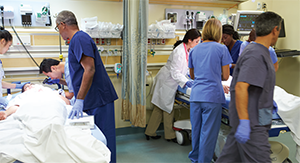CHICAGO—Investigators from around the country presented their findings at the 119th Annual Meeting of the Triological Society, held here May 21-22, 2016, in conjunction with the 2016 Combined Otolaryngology Spring Meetings. Here are some research highlights from the event.
Explore This Issue
August 2016Medical Spending

zimmytws; Monkey Business Images; Dean Drobot/shutterstock.com
Alden Folsom Smith, BMus, a researcher from Fox Chase Cancer Center in Philadelphia, presented his analysis of the geographic variation in Medicare spending. He and his colleagues began their research by hypothesizing that Medicare expenditures for otolaryngology physician services are affected by the regional location of the Medicare beneficiary. To address this hypothesis, their cross-sectional study averaged expenditures for otolaryngology physician services in each hospital referring region (HRR). They utilized the work relative value units (wRVUs) collected by otolaryngologists and divided them by a thousand Medicare beneficiaries in the region (wRVUs/kMCB). While the expenditures by HRR did not change over the two-year period, Smith reported a marked variation in wRVUs/kMCB among HRRs for otolaryngologist services.
Additionally, the researchers found that the relative supply of otolaryngologists, medical specialists, and primary care physicians was strongly associated with the regional expenditures on otolaryngology physician care. The great variation in the supply of otolaryngologists in the regional physician specialty mix was thus driving the differences in regional Medicare expenditures.
Sigsbee W. Duck, RPh, MD, an otolaryngologist with the Sweetwater Medical Group in Rock Springs, Wyo., led a discussion following the presentation, during which he acknowledged the regional variation. “You have more Medicare supply with older physicians and hospital-employed physicians,” he said.
Smith suggested that future studies should address the effect of an otolaryngology residency training program on Medicare spending.
Bottom line: The relative supply of otolaryngologists, medical specialists, and primary care physicians is strongly associated with the regional expenditures of otolaryngology physician care.
Acute Specialty Care

zimmytws; Monkey Business Images; Dean Drobot/shutterstock.com
Matthew R. Naunheim, MD, MBA, resident at Massachusetts Eye and Ear in Boston, presented on the role of acute care in otolaryngology. He explained that, typically, acute otolaryngologic care is provided in emergency rooms (ERs), urgent care, primary care, or otolaryngology offices. There are, however, a few dedicated otolaryngology ERs, one of which is the ophthalmology- and otolaryngology-specific ER at Massachusetts Eye and Ear.
Dr. Naunheim and his colleagues designed the study to determine the value of acute otolaryngology services, measuring health outcomes achieved per dollar spent. The researchers approached the question using contingent valuation, explaining that “goods and services that have no explicit market value can still be valued using contingent valuation.” Contingent valuation directly assesses patient preferences, thereby valuing perceived health outcomes. The study authors distributed a survey of 17 questions to 327 patients to assess demographics as well as valuation of care. The valuation questions explained scenario benefits of specialty care versus general care.